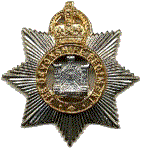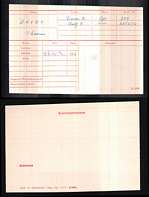Thomas Davey was born in the last quarter of 1884 (Ref; Torrington 5B. P.489). In the 1901 census he is recorded as the elder son, aged 16, of William Davey an agricultural labourer living in a 4 roomed cottage on Church Hill, with his wife Jane and Thomas’ brother William, aged 15. By 1911 Thomas had been married for five years to Maud Mary Turner, and a child had been born, William Thomas aged 3.
Sadly, Thomas’ war records did not survive the blitz, and there are no pension records, so we have little to tell us of his war service. However, his medal cards is available and we know of course from the Roll of Honour in the church that he served in the Devons and that he survived the war, and the Chumleigh Deanery Magazine for September 1914 proudly announced that Thomas Davey was already serving in the 6th Devons (Territorials) and was among the first in the village to serve.
The medal card we have relates to Sgt. Thomas Davey who had enlisted first in the Devons and had then transferred to the Bedfordshire Regiment. Changing a regiment usually occurred after recovery from wounds or sickness followed by a re-posting - a constant grumble in the army that other ranks would then lose the comfort and support of returning to their old unit. However, Sgt Davey was not apparently awarded the Victory Medal (probably overlooked in his records) nor the 1915 medal - but this is accounted for by the fact that the 6th Devons were not awarded it because they served initially in India and this was not considered to be a war area.
To reach the rank of Sgt. Thomas would almost certainly have enlisted in the 6th Devons (Territorials) before the war. His early army number is not recorded. The longer number relates to the changes made to army numbering in 1916. In January 1919 the newly published Parish Magazine, begun by Rev. Nesbitt almost as soon as he arrived in Winkleigh, gives us news of Thomas Davey : ‘We are very sorry to hear that Sgt. T.Davey is seriously ill in India.’ However, the following month we read much more cheerful news: ‘We are very glad to hear that a letter has been received from Sgt. T.Davey, who though still in hospital in India, is much better.’
An outline of Sgt.Thomas Davey’s service in the war follows the fortunes of the 1/6th Battalion in India and Mesopotamia.
August 1914: in Barnstaple. Attached as Army Troops to Wessex Division.
On 16 September 1914 came under orders of Devon and Cornwall Brigade.
9 October 1914: sailed for India, landing Karachi 11 November 1914.
Came under orders of 3rd (Lahore) Divisional Area at Lahore.
January 1916: joined independent 36th Brigade in Indian Army.
5 January 1916: landed at Basra, and remained in Mesopotamia for the rest of the war.
12 May 1916: 36th Brigade came under orders of 14th (Indian) Division.
September 1916: came under orders of the Tigris Lines of Communication.
The story of the history of 1/6th Devons, both in India and Mesopotamia, up until the disaster at the battle of Dujailah on March 8th 1916, can be read in full by referring to the account of Thomas Knight, who died at Dujailah and whose name is recorded on the Winkleigh Memorial Cross. Depending on when he was evacuated sick to India, Sgt. Davey would have experienced everything the Battalion endured, followed of course by the events that followed the battle of Dujailah on March 8th 1916, where 9 officers and 43 other ranks had been killed or missing and 8 officers and 181 other ranks had been wounded. For the survivors, the march back to the wadi at Orah carrying their wounded on their backs until bearers were found, or on spring-less carts, was very depressing. The loss of officers was particularly acute: less burdened in the battle than the men, they had run ahead of their companies in the attack and had been the first to have been mown down by Turkish fire. The men were completely exhausted, having been in action for some twenty-one hours, with only their water bottles to quench their thirst and carrying fifty-six pounds of equipment.
The next three weeks were spent at the wadi, trying to increase the bunds to prevent the Tigris from inundating the whole area. On March 31st the whole 36th Brigade moved to Orah in Corps reserve. On April 6th when the 13th Division attacked the Hannah and Falahiyah positions, in a last desperate attempt to relieve Kut, the 1st/6th was involved only by giving covering machine-gun fire from the right bank. After this the Battalion took over some captured trenches at Beit Aiessa, and then on 21st April gave support to the Meerut Division in the last (and failed) attack on Sannaiyat, before moving back to Abu Rahman on the day that Kut finally surrendered, April 29th.
In May 1916 the whole Mesopotamia Force was reorganised: the 1st/6th left the 36th Brigade for the Line of Communications, guarding and defending from marauding Arabs key points that led upstream from Basra. Fresh drafts were received from the 2nd/6th in May, June and July, but sickness and exhaustion had taken their toll. Only 7 officers and 180 men remained reasonably fit for guard duties requiring 147 men each night. On August 13th a burial party visited the battle site of Dujailah: 20 bodies were buried and identifications secured. In September the Battalion moved to Sheik Saad, and in October to Amara at which time it totaled only 9 officers and 276 other ranks. By February 1917 new drafts had brought the Battalion up to over 950 strong. The Battalion’s task was now to protect the light railway that ran from Sheik Saad to the Shatt al Hai. Here they stayed well away from General Maud’s campaign to advance to Baghdad and beyond, protecting the railway and collecting battlefield salvage, and having occasional brushes with Arab marauders. In April 1917 there was a move to Shaiba on the Euphrates, west of Basra, with many personnel moving to India to recover from sickness, or for periods of leave. Life was far from comfortable, however, with temperatures in July and August reaching a maximum of 124 degrees.
The end of the war in November 1918 saw the 1st/6th at Magil Camp, Basra, recovering from the attacks of the Spanish influenza epidemic which had been raging since October. Later in November the Battalion moved back to Shaiba, where 200 men and one officer were dispatched to Salonika. On 6th December the remainder moved up-stream to Amara, where demobilization began.
Of great interest in Winkleigh was the order in which men were demobilized. Before the New Year only schoolmasters and students were released from the Battalion, but in January 1919 married men with four years overseas went first, then coal-miners and men over 41. There were in fact 371 men with the Battalion who had had four years overseas since August 4th 1914, and three officers and 110 men with three years. On March 30th the remainder of the Battalion left for Karachi, but disappointment followed, as the Battalion was expected to be reinforced and dispatched for duty on the North-West frontier against Afghan tribes who had broken out in revolt. In the end the duty was cancelled but not before the men had endured a hot and weary summer, and did not finally leave Bombay until July 27th reaching Plymouth on August 16th. On the 19th they reached Barnstaple to be given a warm reception at the Guildhall attended by the Lord Lieutenant, the Mayor and Town Council, before its members dispersed to their homes.
It is not known when Sgt. Thomas Davey reached home from India.
It is interesting to read the account in the ‘Western Morning News’ of the 1st/6th, written as a special article for the unveiling of the Memorial to the 6th Devons in Barnstaple on 18th July 1922. The colossal blunders of the whole Mesopotamian campaign, and in particular the appalling mistakes made at Dujailah which resulted in so many needless deaths, had either not yet been revealed by historians, or were deliberately concealed for the purposes of the ceremony. The article appears in the special topics on this site.
16 July 2011



 205454 Bedfordshire Regiment
205454 Bedfordshire Regiment